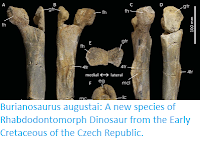Opal is an amorphous form of silica containing as much as 21% water, It
is made up of tiny spheroids of crystalline silica some 150 to 300 nm in
diameter, with random alignments to one another. Light passing through
these crystaloids is refracted as by a prism, leading to the
'opalescent' sheen which gives the mineral its value. Opal is formed by
water percolating through silica rocks, where it dissolves some of the
mineral forming a silica-rich solution. This can accumulate in any
cracks or gaps in the rock, where if it reaches a high enough
concentration it can precipitate out as opal. The Cretaceous Griman Creek Formation of northern New South Wales and southern Queensland is noted for the occurrence of opalisedvertebrate fossils, replacement fossils formed when opal forms in gaps in the rock left by the dissolution of bone or earlier replacement material. However, these are rare and are not always spotted in areas where the opal is mined using mechanised equipment, which also means that the material that is recovered is often fragmented.
In a paper published in the Journal of Vertebrate Paleontology on 3 June 2019, Phil Bell, Tom Brougham, Matthew Herne, and Timothy Frauenfelder of the University of New England, and Elizabeth Smith of the Australian Opal Centre describe a new species of non-Hadrosaurid Iguanodontian Dinosaur from a bone-bed within the Griman Creek Formation exposed in a mine targeting the Sheepyard Opal Field, approximately 40 km southwest of the town of Lightning Ridge in central northern New South Wales.
To date only a single Iguanodontian Dinosaur has been described from Australia, the possible Rhabdodontomorph Muttaburrasaurus langdoni from the Early Cretaceous Mackunda Formation in central Queensland, though a number of trackways attributed to Iguanodontians are known from Cretaceous Australian deposits, suggesting more members of the group were present.
The new species is named Fostoria dhimbangunmal, where 'Fostoria' honours Robert Foster, the miner who discovered the bone bed from which the material assigned to the species came, and 'dhimbangunmal' means 'Sheep Yard' in the language of the Yuwaalaraay, Yuwaalayaay, and Gamilaraay peoples. The material comes from a bone bed which was partially excavated for its opal content before the fossil nature of the material was recognised. The material is therefore somewhat fragmented, though it appears to have come from at least four disarticulated skeletons.
Chronostratigraphy and map of the Surat Basin in Australia showing the approximate extent of the Eromanga Sea (blue) during the Albian. Lightning Ridge is indicated by an open square in the main image. Inset showing location of the ‘Sheepyard’ opal field near Lightning Ridge (star). Fostoria dhimbangunmal comes from a monodominant bone bed (triangle) in the uppermost part (Cenomanian) of the Griman Creek Formation. Bell et al. (2019).
The material referred to the species comprises a partial skull roof and braincase, right quadrate, four partial and complete scapulae (three of which are left, with the single right specimen being different in size to any of the left scapulae, hence the estimate that there are at least four individuals present), a left humerus, a probable left radius, a right ischium, portions of left and right femora, a left tibia, a probable partial left fibula, and a number of partial metatarsals, pedal phalanges and vertebrae.
Fostoria dhimbangunmal, forelimb and girdle elements. Left scapula in (A) lateral; (B) medial; and (C) anterior views. Left humerus in (D) posterior; (E) medial; and (F) anterior views. (?) Left radius in (G) medial; (H) lateral; and (I) proximal views. Abbreviations: ac, acromion ridge; c, sutural contact for coracoid; df, deltoid fossa; dp, deltopectoral crest; gl, glenoid fossa; gr, medial groove associated with coracoid foramen; mr, medial ridge; r, ridge; sg, supraglenoid fossa. Scale bars equal 2 cm. Bell et al. (2019).








